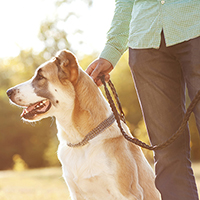Hip dysplasia is caused by poor formation of the hip joints, which is a universal growing disease with younger dogs of almost every breed. With larger breeds, unsteady hip joints are customary, although hip dysplasia can be a serious dilemma that will limit the physical movement of your Golden Retriever. Although many Golden Retriever lovers don't realize it, hip dysplasia is something that dogs inherit from their parents, and it usually worsens with age.
The signs and symptoms of hip dysplasia are virtually impossible to detect in Golden puppies, although they will start to exhibit signs once the they have reached the age of nine or ten months. Even though you might take your Golden Retriever to the veterinarian to have him examined, your vet will probably tell you that you need to wait until your dog reaches a certain age before you notice any symptoms.
The symptoms and signs of hip dysplasia vary. The most common symptoms are crippling, or the inability to walk properly. This disease can get better as soon as the dog gets older due to the joints stabilizing, the inflammation disappearing, and the muscles in the hips getting stronger and more mature. Keep in mind however, that Goldens who suffer from hip dysplasia when they are younger will most likely develop arthritis as they age.
Golden Retrievers that suffer from hip dysplasia aren't fit for breeding, although they can still live a prolonged and healthy life. There are selected drugs that your vet can prescribe to your dog, which will help him control his weight, and help control the disease. In addition, these drugs can also cut down on his pain and muscle inflammation as well, helping your Golden Retriever enjoy himself as much as as any other happy, healthy dog.
A number of Golden Retrievers that have hip dysplasia won't start to show any signs at all until they are a few years old and their muscles start to wear down. At this point, damage to the hip muscles will start to become more noticeable. Although your dog may be active and healthy for most of his younger years, dysplasia can slow your dog down and potentially make him look as if he is old and is suffering from the physical effects of arthritis.
To get rid of the pain of hip dysplasia, surgical options are available. Golden Retrievers have a high tolerance for pain, and won't normally display any signs, even when they are experiencing it. X-rays won't alert you to any signs of pain either, but limping or slow walking will tell you that your dog is tender. Golden Retrievers who have this disease don't know it - which is why you should help your dog as much as possible. If you do your part and help your dog seek relief, he will feel better than ever. Because Golden Retrievers are so brave, you might never know he was hurting at all.

 How to Stop Your Dog From Eating Rocks
How to Stop Your Dog From Eating Rocks
How to Stop Your Dog From Eating Rocks
How to Stop Your Dog From Eating Rocks
 Arthritis in Dogs Treatment – What To Choose?
Like h
Arthritis in Dogs Treatment – What To Choose?
Like h
 What To Do If Your Dog Ate Chocolate
Chocolate is toxic to dogs and depe
What To Do If Your Dog Ate Chocolate
Chocolate is toxic to dogs and depe
 Can Dogs Eat Strawberries
Warm weather means that fresh fruit
Can Dogs Eat Strawberries
Warm weather means that fresh fruit
 What Your 9-month-old Puppy Needs
What Your 9-month-old Puppy Needs
What Your 9-month-old Puppy Needs
What Your 9-month-old Puppy Needs